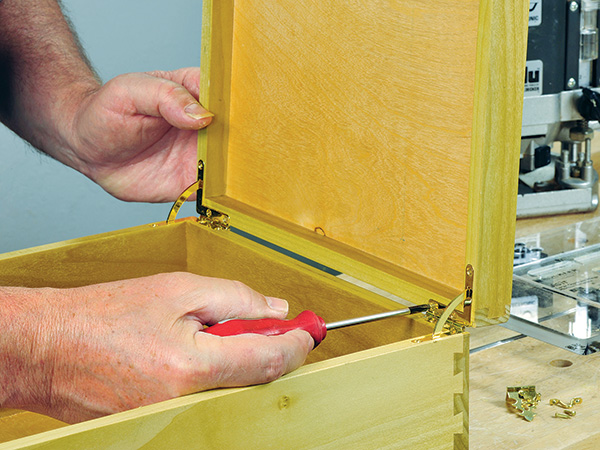
Just like in every other aspect of woodworking, there are tried-and-true methods for making hardware installation an easier, cleaner and more precise process, as well as reducing the chance of running into problems. In this article, I’ll present some of the procedures I’ve found particularly useful for installing some of the most common types of cabinet and furniture hardware, including pulls and knobs, hinges and drawer slides. I’ll also offer some general tips for mounting just about any hardware that’s screwed or nailed on. And, just in case you run into problems, I’ll show you a few good tricks for remedying them (or avoiding them in the first place).
Obviously there’s a ton of specialized hardware out there beyond the scope of this article (lazy Susans, flipper door hardware, electric lifts, etc.). For such specific hardware mounting information, I strongly urge you to read the instructions that come with your hardware. Better still, you can almost always find instructional videos on the Internet that show you exactly how to install special types of hardware.
Choosing Hardware
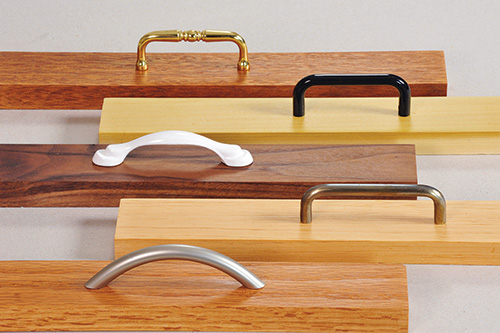
Peruse the pages of a hardware catalog, and it’s easy to be overwhelmed by the number of choices. Unless the style of the piece you’re building dictates the style of hardware you’ll use (Shaker, Craftsman, Ultra Modern), your hardware choices can have a significant effect on the appearance. For example, a simple, clean lined cabinet fitted with stainless steel wire pulls will tend towards a contemporary look; white ceramic knobs offer a country feeling, and antique brass bail style pulls lend a classical appearance.
Hardware that’s prominently located (knobs, latches, etc.) should be chosen to match the scale of the parts it’s used with. For example, tiny pulls on big doors may seem out of place or simply appear incorrect.
Hardware finish also affects final appearance considerably and should be chosen not only to suit the style of your piece, but to work harmoniously with the color and grain of the wood your project is built from. For example, black anodized pulls offer good contrast when fitted on a natural maple project but likely would be too subtle if used on a dark wood piece.
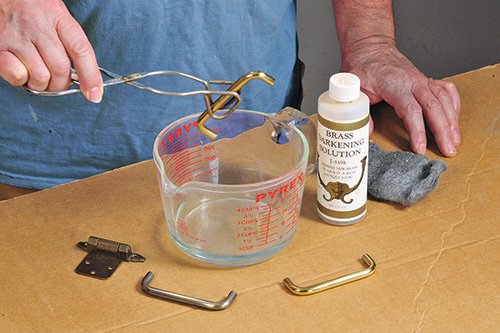
If you find brass or bronze hardware that you like, but it has too shiny a finish, you can actually create a darker, duller look with a brass darkening solution. Start by removing the protective clear coating from the shiny brass by scrubbing thoroughly with a steel wool pad dipped in acetone or lacquer thinner (wear protective gloves). Now fill a small glass bowl or disposable plastic cup with darkening solution and immerse the hardware in it, including screws used to mount the hardware. Leave them soaking until they achieve the desired shade of darkness, then rinse them thoroughly in clear water. If the pieces still aren’t dark enough, repeat the soaking/rinsing process. If pieces end up too dark, you can lighten their finish by rubbing them with fine steel wool.
Screw-on Hardware
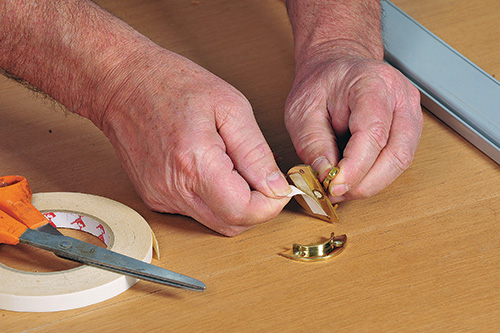
One of my biggest hardware mounting pet peeves is seeing beautiful, expensive screwed-on hardware that’s either mounted crooked or has screws with stripped heads. To prevent these problems, here are some practical steps to follow when mounting hinges, latches, trunk corners, or just about any other kind of screwed-on hardware. Start by determining and marking the exact position of your hardware. If the hardware spans two separate parts, say a clasp fastener that locks two halves of a tabletop, set the parts together just as they will be after final assembly. If there’s supposed to be a gap between the parts, use cardboard or thin wood strips to shim them. Now set the hardware in place and either clamp it down or use double-stick tape to secure it.
To assure perfect pilot holes for the mounting screws, it’s best to use a self-centering drill bit. Choose the bit that matches the size of the screws: a 5/64″ bit for #4 screws; 3/32″ for #6 screws; 7/64″ for #8 screws; and 1/8″ for #10 screws. Before drilling, set the bit’s sleeve to limit the drilling depth to match the length of your screws. Keep the bit square to the work surface while drilling, and clear chips from the bit after every hole. A self-centering bit will often work with hardware that lacks countersunk mounting holes. But if it doesn’t, mark hole positions with a pencil, create centered dimples with an awl, then drill the pilot holes with a regular bit.
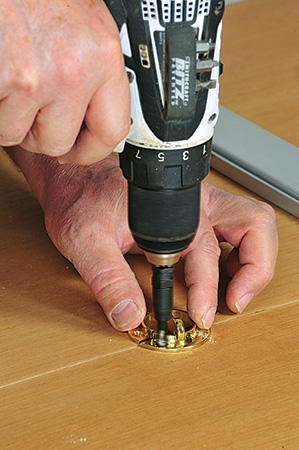
If your hardware has steel screws, or brass-plated steel screws (if you’re unsure, check with a magnet), you’re all set to drive them in place. However, when driving soft brass or bronze screws into harder woods (oak, maple, etc.), it’s best to enlarge the pilot holes with a slightly bigger drill bit (try a bit that’s 1/64″ or 1/32″ larger), to avoid breaking the screws or stripping their heads. You can also “pre tap.” Whether you re-drill or pre tap the pilot holes, it’s best to run a test with spare screws and a scrap of your project’s wood.
When you’re ready to drive the mounting screws, it’s important to choose a screwdriver that fits the screw’s drive recess (Phillips, square, etc.) correctly. If you don’t, you’re in danger of the driver deforming the screw heads in some way and leaving an ugly result. Take special care when driving Phillips head screws, as there seems to be a stunning number of different sizes and styles. If your hardware comes with slotted-head screws, I urge you to replace them with Phillips head screws — it’s all too easy for a slotted screwdriver to slip out and ruin the screw head or, worse, scratch the hardware or gouge the wood!
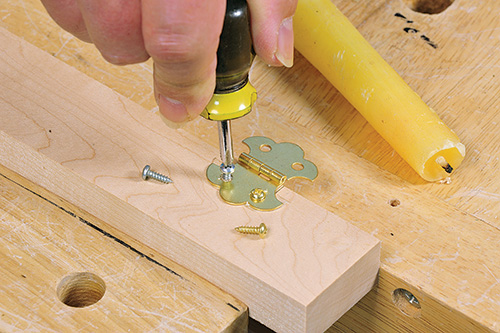
To make driving easier, lubricate mounting screws by rubbing a little wax from an old candle into the threads. To seat the hardware evenly, run all the screws most of the way in first, then go back and tighten them fully, taking care not to apply too much torque. To prevent breaking or stripping screws when using a portable powered drill or electric screwdriver, set the tool’s clutch to the lowest torque setting that’ll get the job done.
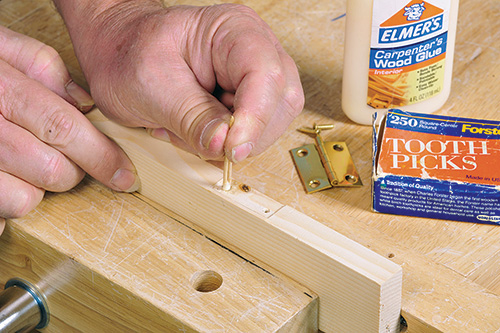
If you do get a “spinner” — a screw that’s fully driven, but won’t stop turning — an old, but effective, trick is to un-mount the hardware, and apply the toothpick trick. After letting the glue dry, re-drill the pilot hole and remount the hardware; just go a little easy when driving the screw.
If you accidentally break off a screw while driving it, don’t panic; if any of the shank is still exposed, try gripping it with locking pliers and unscrewing it. If the shank breaks below the surface, you’ll need to drill out the broken screw with a tubular screw extractor, plug the hole with a short length of dowel, then re-drill the pilot hole and drive a new screw.
Nail-on Hardware
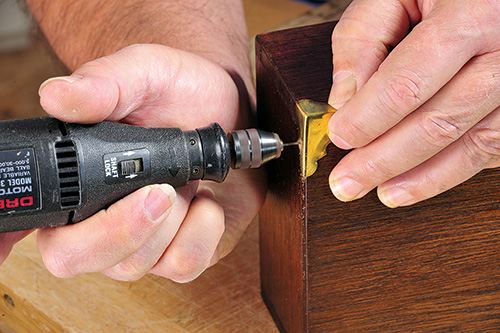
Small nails and pins are often used to mount hardware such as small latches, hinges and box corners. But driving pins directly into hardwoods is simply begging for problems. To keep small fasteners from bending or driving crooked, it’s best to create pilot holes before driving them in place. After positioning your hardware and securing it, use an awl to mark all holes. Just make sure pieces, such as box corners, are fully seated.
Choose a bit for pilot holes that’s slightly smaller than the diameter of the pins. Unfortunately, a 1/16″ diameter bit (the smallest from a regular drill set) is too large for pins size 16-gauge and smaller. Use bits from a numbered small drill bit set for these pilot holes: #55 for 16-gauge; #63 for 18-gauge; #72 for 20-gauge. Also, the chucks on many portable drills can’t handle bits this small, so use a rotary tool fitted with a drill chuck.
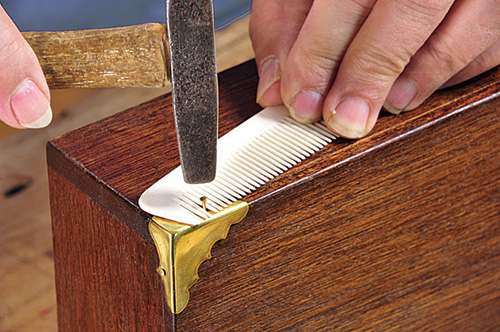
To make the pins easier to drive, rub a little wax on them and use a tack hammer or other small hammer. To avoid smashing your fingers, hold the pin between the teeth of a regular hair comb and leave the comb in place until the fastener is almost fully driven. After removing the comb, carefully tap the pin in until its head is in firm contact with the hardware. Don’t drive it in any farther: you’ll likely deform the pin’s head, and an over-driven nail can easily distort and buckle thin brass hardware.
Mounting Hinges
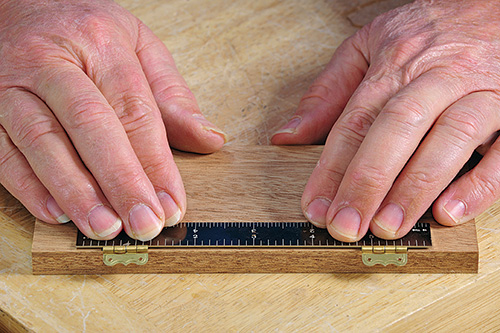
Hinges are needed for any project that has a door, lid, hatch or other articulated parts. Proper installation varies considerably: some hinges are designed to be surface-mounted; others must be mortised into place, while still others require special drilled or routed recesses.
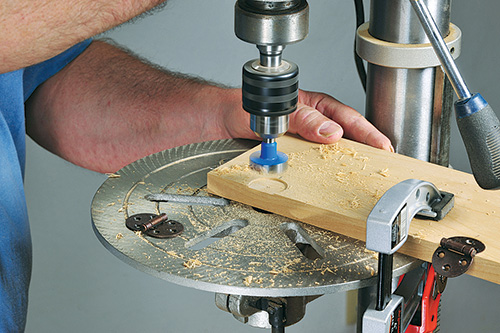
The downside of surface-mounted hinges is that they typically leave a gap between the hinged parts. For closer fitting parts, there are several kinds of hinges that are easy to mount, including Rockler’s Easy Mortise hinges. Hidden barrel hinges are also very easy to install: Simply drill a pair of holes, one for the cylindrical portion of each hinge half, and press them into place.
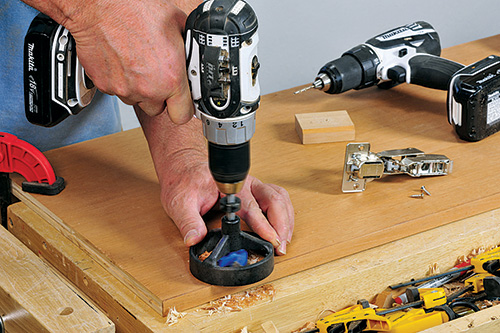
Euro-style concealed hinges, popularly used with frameless cabinets, require a large pocket hole (usually 35 mm) for mounting one half of the hinge. On large doors, these holes can be awkward to bore using a drill press. An alternative strategy is to use a drilling guide to keep the big bit square to the surface.
Mortised Hinges
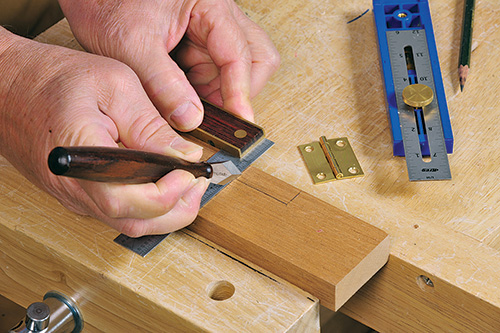
When a project calls for basic butt hinges or any hardware that requires mortising into the surface of the work, here’s my preferred method. After determining the location of the hinges on the work, position each hinge leaf and mark its outline with a razor or marking knife. For rounded or irregularly shaped hardware, stick the leaf down with double-stick tape and carefully trace around it.
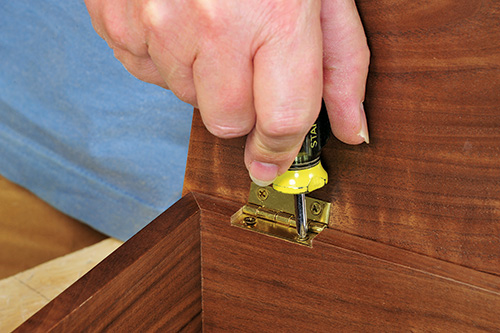
Next, use a small plunge router (or laminate trimmer) with a small-diameter straight bit to remove the mortise waste. In most cases, mortises should be cut just deep enough to position the hinge leaf flush or just slightly proud of the wood surface. But there are exceptions, such as when the mortises must be deep enough to compensate for the thickness of the hinge’s barrel.
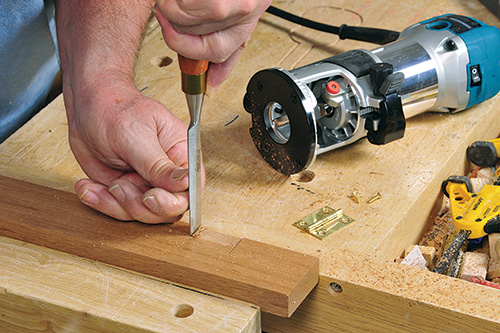
Before routing, darken your knife lines with a pencil, so you can see them more easily, then rout to within about 1/32″ of each line. By setting the bit depth carefully, routing assures a flat pocket of consistent depth. If you accidentally rout too deep, you can compensate by putting a bit of tape on the underside of the hinge leaf, or by shimming it with a small piece of thin cardboard.
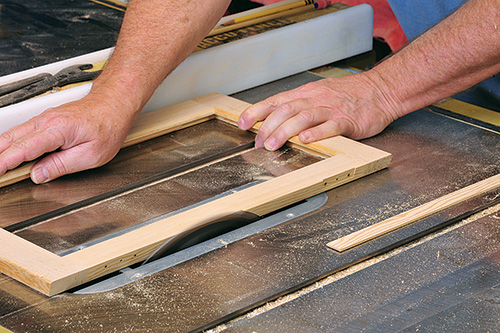
If you have dozens of mortises to cut, say for a production run of jewelry boxes, you’ll get the most consistent results by using a template and plunge router fitted with a guide bushing. The template clamps atop the workpiece and has an opening sized and shaped to produce the desired mortise.
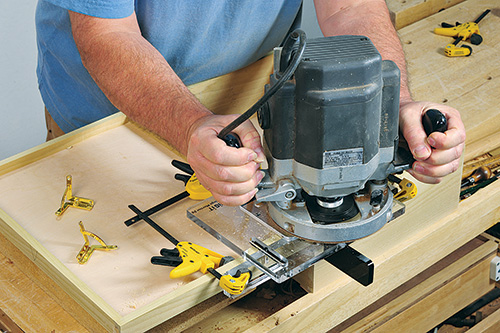
The bushing rides around the opening, allowing a straight bit to rout the mortise with great precision. You can make your own template, or use a ready-made system, such as the JIG IT® Hinge Mortising System.
Knobs and Pulls
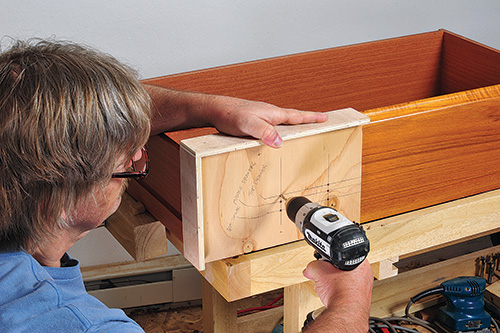
Unless your cabinet or furniture piece is fitted with push-to-open hardware or has doors and drawers with routed finger grips, you’ll need to install some sort of knobs or pulls. When positioning these on drawer fronts, centering them vertically seems like a logical thing to do. However, you’ll find that this doesn’t always look right, especially on the lower drawers of a dresser or kitchen cabinet. This is due to the foreshortened perspective we see when gazing down at lower objects: centered pulls end up looking too low. Hence, it’s common practice to mount such pulls/knobs a little above center. There’s no hard and fast rule for how much higher; it’s best to temporarily tape pulls or knobs onto the finished piece, stand back, and see what looks best to your eye.
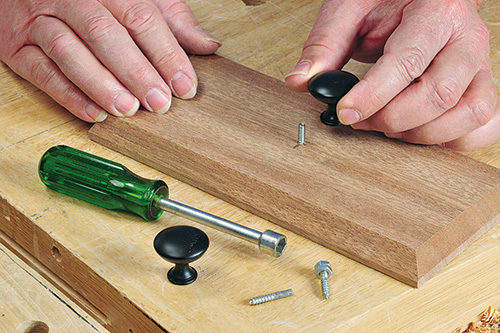
Unless you have only a few to mount, measuring and marking holes for each knob or pull separately is time-consuming and can lead to mistakes. It takes only a few minutes to make a drilling template that will guarantee that all holes end up exactly where they should be. Holes drilled through the template at the desired locations serve to guide the drill bit. Because the stop strips overlap both sides of the plywood, the template can be flipped over and set at either end of a long drawer face, allowing you to drill holes for pulls on both right and left sides.
When the need arises for mounting knobs in thick parts (or when you simply don’t want machine screw heads to show on the inside of a drawer), use a dowel screw.
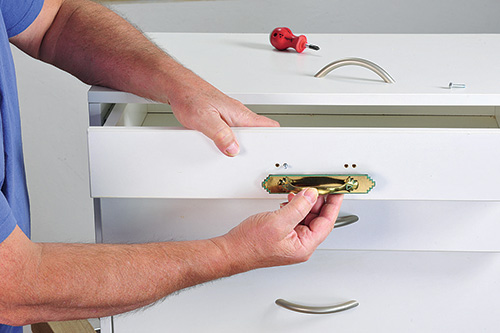
If the holes you drill for mounting knobs or pulls are slightly off, all is not lost. In lieu of filling the holes and re-drilling (trust me, you’ll see those bad holes no matter how well you fill them), you can fit the pulls with backplates (or choose bail style pulls which have their own wide backing plates). Many styles of pulls (and knobs) have matching backplates, but you can always mix and match, or even make your own backplates from wood.
Drawer Slides
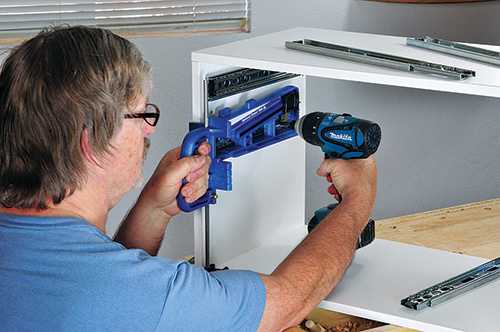
If you are using metal drawer slides in your cabinet or furniture project, your choices are almost as overwhelming as those for hinges and pulls. Basically, you need to choose a set of slides with adequate length and weight capacity as well as enough extension to allow easy access to items in your drawers. These days, some slides are available in different finishes, including black, white and brown. Using a black slide with light wood drawers can look classier than the typical nickel-plated steel slides.
Once you’ve picked the slides that best suit your application, you face the challenge of building your carcass and drawers to suit the requirements of the slides. Read thoroughly through the mounting instructions before you start building to avoid ending up with drawers that don’t fit or won’t work with your slides. One problem to avoid at all costs is ending up with a cabinet and/or drawer boxes that aren’t square. If the sides of the carcass are not parallel, or aren’t square to the front, your drawers will never close properly, regardless of the type of slides you’re using. Even if you adjust the individual slides forward or backward so that they catch in the closed position, your drawer’s face will still end up crooked relative to the cabinet’s face frame or front edges.
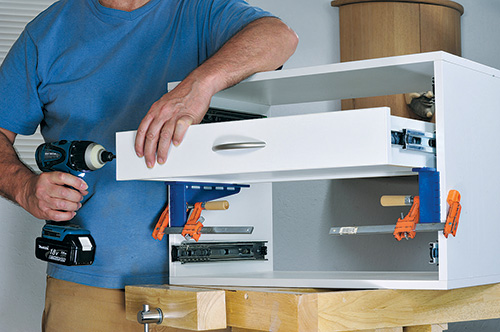
Another all-too-common mistake is to fail to subtract the thickness of the slides from the overall width of the drawer. If you find yourself in this situation, you may be able to avoid building new drawers by switching to under-mount style slides (if they’re just a skosh too wide, you may be able to sand down the drawer sides to offer more clearance). On the other hand, if your drawers end up being too narrow, it’s fairly easy to install shim (strips of cardboard or veneer) under the cabinet-mounted portion of each slide.
In order to end up with drawers that operate smoothly with faces that are evenly aligned to the cabinet and to one another, each pair of drawer slides must be mounted at precisely the same height and parallel to one another. Further, the cabinet-mounted portion of each slide must be square (vertically) to the front of the cabinet/drawer housing. You can certainly achieve this by careful measurement, but it’s easier to use a universal slide mounting jig. The jig aligns and supports the cabinet-mounted portion of the slide while you screw it in place.






